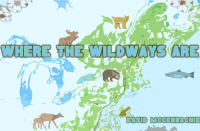Follow Marine Biologist Carl Safina as he takes viewers around the world to show us how today’s ocean issues are being solved in his PBS series “Saving the Ocean.” You can watch full episodes online at the PBS website. Here at A/J he’s giving us a behind the scenes look at each episode.
Follow Marine Biologist Carl Safina as he takes viewers around the world to show us how today’s ocean issues are being solved in his PBS series “Saving the Ocean.” You can watch full episodes online at the PBS website. Here at A/J he’s giving us a behind the scenes look at each episode.
Pachico Mayoral is telling me that after a terrifying approach by a whale in the early 1970s, he felt that he and that whale had made peace, and that “the whales have forgiven us for all we did to them.”
Shortly after breakfast we boarded 2 outboard-powered open boats captained by Pachico and his son Jesus, who started guiding visitors to the whales here when he was 14.
In no time we were among so many spouting, rolling whales that I could not count them. It seemed there were always a dozen or so within a few hundred yards of us. Overall, Jesus told me, there were about three hundred gray whales in the lagoon.
In the Atlantic, Gray Whales were hunted to extinction. And here they barely escaped the same. Whalers in the 1800s found the three major lagoon systems (San Ignacio, Scammon’s, and Magdalena Bay) where they come in late winter to give birth and to mate, and they showed no mercy. But some survived, and more than a century later they recovered numbers enough to approach, it is thought, their pre-hunting abundance. Their total population now stands over 20,000, coast-wide.
Not that the whales had taken it without a fight. Gray Whales earned a reputation for fierce resistance when harpooned or defending their young. Many a harpooner found himself in the water surrounded by the splinters of his boat. Whalers called the Grays “devilfish,” of all things, for trying hard to stay alive.
In the early 1970s, when there were still far fewer whales here than there are now, Pachico Mayoral found himself being approached by one of the feared whales while alone in his small boat. He was terrified. To his amazement—and for perhaps the first time in the history of the world—the whale approached the man so closely that he reached out his hand and, utterly astonished, he stroked its furrowed back. In that moment the world changed just a little.
They come here to give birth and to mate. So pregnant females as well as males and females seeking mating opportunities all enter the lagoon in winter and spend several months. The babies put on about 50 pounds a day.
But they look and act like babies. They’re oriented to their moms and they’re active and playful. Not that the adults aren’t active. We frequently saw enormous heads rise straight up and slide down again, “spy-hopping.” And there was the occasional lagoon-detonating full breach, visible over long distances.
This place is very well managed. A world Biosphere Reserve, the whale-watching is limited to core areas, with other areas off-limits. A guard, hired by the tour operators, “to keep it a nice experience,” says Jesus, polices the rules.
We encountered a completely mellow 40-foot mother and her frisky 20-foot-long baby. The calf came right to our boat, and when its eye met mine what I saw was not a look of wisdom or of caution, but the innocent curiosity we are all born with, before the hardening of the world sets in.
I was wondering about bothering these beasts. My concern was dispelled by Jesus instructing, “If it comes to us, you have to pet it. If you don’t, it might leave.”
The baby lifted its head alongside the boat. With no hesitation I landed my palm on its snout and stroked its head. It was soft, rubbery, with a few short bristles you could easily see and feel. Cleary the animal easily feels you. I patted it more vigorously and it half-spun and presented its chin, which I duly scratched. I talked to it as I would have talked to a puppy. It was that kind of interaction. Safe, playful, innocent—and understanding. The whales knew the drill.
I thought about people who once came here to kill these whales. I thought of these wide-eyed innocents following their moms toward Alaska and the Killer Whales who, experienced in interception, would trigger terror en route and the full fury of these mothers to defend their babes.
Most of the while, this mother simply lay there. But a couple of times she put her head in reach. When she rolled, her bottom looked like a boat ramp, like you could easily walk out on her.
I’ve seen many whales, often at very close range. But these interactions, unique in the world as far as I know, represent the relationship with animals and nature that I wish we could have everywhere, all the time.
“Often, over all these years,” Pachico told me, “I have wondered what message the whales are trying to give us. But what I have learned from being with them is that the world is for us to share.”
If only we could all simply learn just that. Perhaps that message is so big, it does indeed take a whale to bring it out in us.
Read Carl’s second blog post on Swordfish and check out additional footage from the series on YouTube.
Safina is founding president of Blue Ocean Institute at Stony Brook University, where he also co-chairs the University’s Center for Communicating Science. He has authored 6 books and roughly 200 scientific and popular publications, including features in The New York Times, and National Geographic and a new Foreword to Rachel Carson’s The Sea Around Us. He hosts Saving The Ocean on PBS television.












